Holywell workhouse workhouse, Flintshire
Up to 1834
In September 1739, the Holywell Vestry authorised authorised money for the setting up of a workhouse or poorhouse. The workhouse was erected over the course of the next few months at Castle Hill near St Winifred's Well. Initially, its capacity was limited to six inmates. The first master was a Mr Phillips and the inmates were employed in making clothing for other paupers in the parish. Between 1766 and 1768 the workhouse was 'farmed' by a Mr Thomas Hughes but was then closed. A new poorhouse opened in 1779 but it, too, closed in 1784.
After 1834
Holywell workhouse Poor Law Union was formed on 25th February, 1837. Its operation was overseen by an elected Board of Guardians, 27 in number, representing its 14 constituent parishes as listed below (figures in brackets indicate numbers of Guardians if more than one):
County of Flint: Caerwys, Cileen, Flint (2), Gwaenys-gor, Halkin, Holywell (5), Llanassa (2), Mold (5), Nanerch, Nerguis, Newmarket, Northop (2), Whitford (2), Yscifiog (2).
The population falling within the Union at the 1831 census had been 36,608 with parishes ranging in size from Gwaenys-gor (population 247) to Mold (9,385). The average annual poor-rate expenditure for the period 1834-36 had been £11,119 or 6s.1d. per head of the population.
Holywell workhouse Union workhouse was erected in 1838-40 at the south of Holywell and was designed by John Welch. The Poor Law Commissioners authorised an expenditure of £6,200 on its construction which was to accommodate 400 inmates. The workhouse design followed the popular cruciform or "square" layout with separate accommodation wings for the different classes of inmate (male/female, infirm/able-bodied etc.) radiating from a central hub. Its location and layout are shown on the 1912 map below.
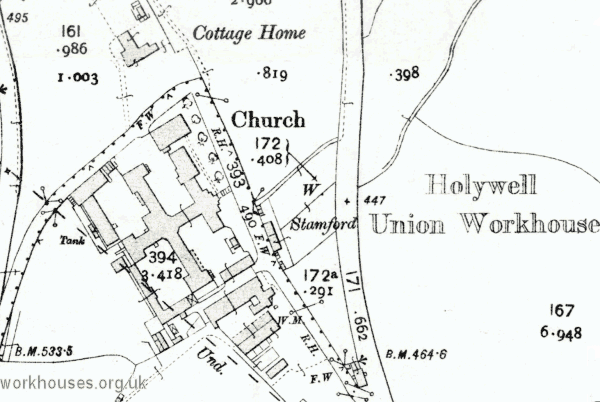
Holywell workhouse site, 1912
An imposing entrance and administration block, three storeys high at its centre with two-storey wings, stood at the east of the site.
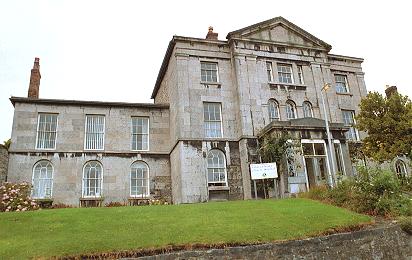
Holywell workhouse entrance block from the east, 2000.
© Peter Higginbotham.
To the rear, a central three-storey range connected to the central supervisory hub who observation windows gave a clear view over all the inmates yards. The main accommodation blocks ran north and south and had cross-wings at each end.
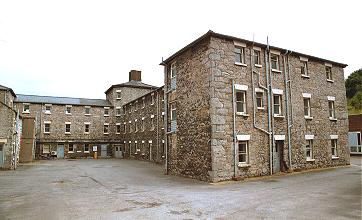
Holywell workhouse north courtyard from the north, 2000.
© Peter Higginbotham.
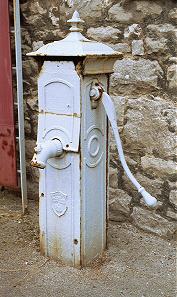
Holywell workhouse yard pump, 2000.
© Peter Higginbotham.
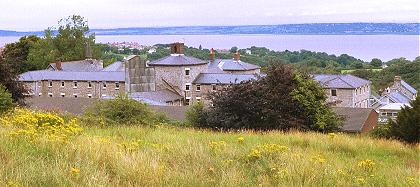
Holywell workhouse general view from the south-west, 2000.
© Peter Higginbotham.
In 1883-4, a chapel was added at the north of the workhouse.
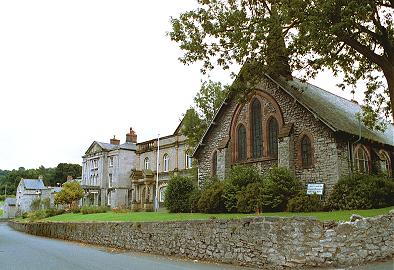
Holywell workhouse chapel from the north, 2000.
© Peter Higginbotham.
The buildings were extended in 1902, and a large infirmary was added at the south of the workhouse in 1913. Electricity was installed in 1912 to replace the old paraffin oil lamps.
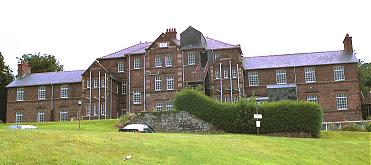
Holywell workhouse workhouse infirmary from the north, 2000.
© Peter Higginbotham.
In April 1917, the workhouse infirmary was comandeered for use by military patients with almost 500 being treated until the last of them departed in January, 1919.
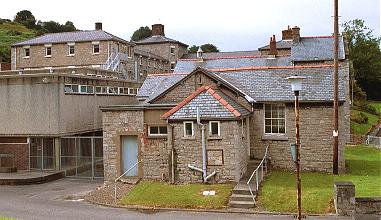
Holywell workhouse workhouse general view from the south-east, 2000.
© Peter Higginbotham.
In 1930, the workhouse passed into local council control and became a Public Assistance Institution. In 1948, the former workhouse became part of the National Health Services as Lluesty General Hospital.
After the hospital closed in around 2008, the site was sold for redevelopment as a residential care home. However, the plans fell through and the building has since been left standing empty and increasingly derelict.
Children's Home
In the early 1900s, the Holywell Union opened a children's home just to the north of the workhouse (see map above). In 1908, the home could accommodate 25 children, with Eliza P. Comins as its Superintendent. The building no longer exists.
Staff
Inmates
Records
Note: many repositories impose a closure period of up to 100 years for records identifying individuals. Before travelling a long distance, always check that the records you want to consult will be available.
- North East Wales Archives (Hawarden), The Old Rectory, Rectory lane, Hawarden, Flintshire, CH5 3NR. The extensive holdings include: Guardians' minute books (1837-41, 1846-1930); Creed register (1914-21); Admissions and discharges (1893-1937); Births (1848-1917); Deaths (1848-1936); Workhouse school register (1872-96); Farm, garden, pig, oakum, stone and wood accounts (1864-1945); etc.
Bibliography
- Jones, Tim (1995) The Holywell Workhouses
- NEW! Workhouses of Wales and the Welsh Borders. The story of the workhouse across the whole of Wales and the border counties of Cheshire, Gloucestershire, Herefordshire and Shropshire. More...
Links
Unless otherwise indicated, this page () is copyright Peter Higginbotham. Contents may not be reproduced without permission.


